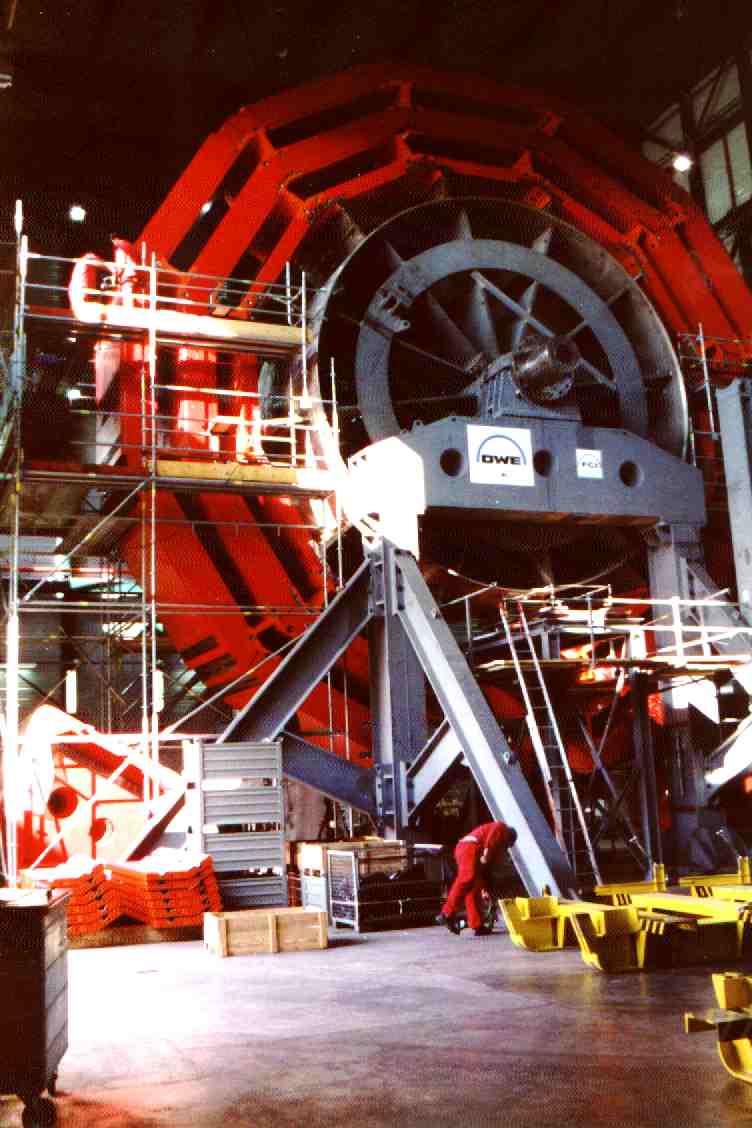 Construction of the CMS Detector
Construction of the CMS Detector
Physics Teachers @ CERN 2004
29th April - 2nd May 2004
For details and to apply click here
Financial support from PPARC available to help meet costs
Teacher
Visits
The
experience of visiting CERN brings first hand knowledge of current developments
in Particle Physics. This greatly enhances the teaching of this topic.
Physics
Teachers@CERN is a three day event and
the CERN High School
Teachers Programme is a three week course which takes
place in July. Click here
for details of CERN teacher programmes.
For
an account and pictures of the UK Teacher Visit of February 2001, click
here.
For an account and pictures of Physics Teachers@CERN
2002 click here.
For an account and pictures of Physics Teachers@CERN
2003 click here.
If you are interested in joining any future teacher visit please contact Andrew Morrison.
Taking
a School or College Group
Over
50 UK school groups have visited CERN in the last twelve months.
The experience of actually seeing the scale of the operation and of talking
to the researchers who work there is very motivating. Equally, the
atmosphere of a major international collaboration is well worth sampling.
For details of how to arrange a visit, click here.
Alternatively, to order a Guide to visiting CERN from the UK contact Andrew
Morrison.
The programme included talks on Particle Physics at CERN and visits to experiments - including the construction site of the CMS detector to be used on the Large Hadron Collider (LHC), the Antiproton Decelerator/Antihydrogen Experiments and a Medical Accelerator (LIBO) developed at CERN. Guides and speakers were provided from CERN staff - of several different nationalities - all of whom communicated their knowledge with great enthusiasm.
Transport was by air from Luton or Liverpool via EasyJet (costs from Luton under £100). Two nights of high quality accommodation were provided free in the CERN Hostel thanks to support from CERN's Outreach Division.
For a full description of the visit by one of the participants, click here.
For pictures of the visit, click here.
A Visit to CERN
In the long distant days of last summer term I was delighted to be able to join a trip to CERN having volunteered to organise a trip for the sixth form in the school which I was about to join. However as the first long six months in the new school drew towards an end and February half-term appeared on the horizon, the last thing I wanted to do was to spend two and a half days of my precious time travelling or on a course for teachers, even if it was at CERN in Geneva.
Having put off the final decisions for a long time, I was able to persuade my jealous family that I should go to Geneva without them. So I booked my flights and purchased some currency before half term and was, despite my tiredness, interested in the proposed programme. Monday therefore found me packed and ready to be taken to the station for the Thameslink train direct to Luton Station and the bus for the airport.
I arrived in time and was delighted to see Andrew waiting and welcoming, beside the check in desk and introducing members of the group to each other. I still had time to arrange travel insurance and even more currency as friends and family were sure thatthe £110 already changed was insufficient. By the time we actually boarded our delayed plane, members of the group had started to get to know each other and of course were discussing physics and physics teaching. The flight was uneventful except for a great view of the Eiffel Tower and the sprawl of Paris by night. We were met by Antonella and her husband, who efficiently organised taxis to our destination hostel in CERN despite the late arrival about which they had been warned by Andrew's concerned telephone calls. It was a clear starry night so after settling into our very comfortable rooms, we all got together to discuss life, the universe and everything in the restaurant, café, bar and general meeting place before finally going to sleep ready for the busy day ahead.
We met in the restaurant for breakfast and were instructed into the systems of the restaurant. Warning - make sure you have plenty of liquid at this stage because you may not get any for another four and a half hours or so, but who was counting! Wewere taken together to Microcosm by Phil who is now an old hand at CERN, a useful thing in such a large place. There we had a talk about CERN as an organisation with multinational collaborations as well as the birthplace of the web. We also were told about some of the experiments related to the Large Hadron Collider which is to be installed soon in the existing tunnel. This introduced us to the physics of the accelerator and of the experiments. Some problems which had to be solved in theengineering design of the Compact Muon Solenoid, CMS, in particular and its construction were described. These became clearer as we were taken on a tour to see the construction as it was actually happening. The size of the device and the difficulty in constructing it became much clearer when I was wearing a hard hat and watching huge chunks of metal and concrete being moved around in a volume similar to a whole small school. If students see this and realise that this is to measure tiny particles that cannot be seen and that the whole instrument has to be moved about 100m underground, they may begin to understand the achievements of the scientists and engineers involved with CERN. Our travel around the 27 km site gave us a chance to admire the Swiss and French scenery so obvious outside the building.
Later we were bussed to the see the superconducting dipole and quadrupole magnets being tested - 3 blue and 1 red in the pictures - and again to hear about the engineering difficulties which had been overcome and the precision needed in the measurements so that the protons would travel correctly in the desired path. Details of the huge currents, low voltages and large current densities were given as well as the problems which might occur if there were localised heating. A great respect for the scientistsand engineers who were putting this all together was growing stronger with each talk and visit. Of course, their skills as linguists were also obvious and I certainly envied and admired their ability to converse fluently in many different languages.
We were then given over one hour to have lunch. The restaurant is a very differentplace from 12 noon to 3 p.m. when it overflows with people and languages. It is an interesting place to sit, watch and listen to those around you. Breakfast and lunch are quite cheap with meals being under £6, though of course it depends on the extras - the cakes at lunch time and fruit salads and croissants at breakfast were tempting. Whilethe buildings in the main area site could be put anywhere in Europe, the restaurant certainly made it clear to me that this was not an international hotel in England but part of another country, as many of the non-scientists are local people and the lunch menu does add Swiss flavour.
The afternoon was given to descriptions and examples of the support services for education, whether for public visits, school educational visits for children or teachers or through the website. These I found interesting, though others felt that they were unnecessary. They did give us a chance to see and meet the people with whom we would be liaising over a visit, which is helpful. I wondered whether we should have been given some information and an opportunity to actually plan a visit and see where the difficulties actually are. We were allowed to visit Microcosm and were allowed toexperience some of the fun physics, such as cryogenic ice cream and the snuffing of a candle from many paces. We had a little time to visit the exhibition which has some very interesting displays of particle physics and the related experiments, past and present. Some are interactive while others are attractive displays for reading. By now it was close to 5 pm and time to reflect, and agree a meeting place for our evening excursion to Geneva. Some of us visited the restaurant for a cup of tea and a cake, while others returned to their rooms, preferring to return for a slightly different beverage before going to town. After all it was our holiday. Andrew and others had done their homework and had chosen some good restaurants at reasonable prices.
Armed with our 2 francs 20, we marched off for the bus and despite my being unable to operate the ticket machine, eventually we were all installed for our 40 minute drive to Geneva. We walked past the first recommended restaurant but some chose to stay there and have a mammoth Swiss meal for a very reasonable price - under £20 all included. Then of course we had to visit Lac Leman but the cold drove us back to the comfort of CERN's restaurant before going to sleep.
Breakfast was less daunting on the second day and we were more confident in returning to our lecture room in the Microcosm building. The theme in the morning was antimatter and we were given a theoretical lecture by John Ellis, whose name has appeared in many articles since our return, followed by practical details of the antihydrogen experiments being built and tested by Rolf Landau, whose presentation was entertaining and educational. His insights into life as an experimental physicist were excellent, giving a good flavour of the reasons for 'doing' such fundamental research and the scientists' perspective on the methods and outcomes. He was wonderfully honest about the scientific method employed. This is certainly something that students should hear. We were taken to the antiproton decelerator with a great number of concrete blocks and its control room with champagne bottles reflecting significant events in the project. We were able to see where some of the experiments would be conducted and are currently being tested, and were given further insights into the choices being made as part of the experimentation.
We visited more red and blue magnets, but in this case they also had cooling devices for the antiprotons themselves. Personally I found this the most enlightening visit, because of the view into the mind of a scientist, Rolf Landau.
After lunch, the use of proton accelerators for medical therapy was described as well as the various organisations which are working together to develop a prototype. We were taken to see the team and their display, which also features on the current issue of CERN Courier. I found this fascinating as this experiment demonstrated the problems associated with small scale engineering of tuning resonant microwave cavities and then the macroscopic problem of brazing all the cavities microscopically together in one furnace. As an ex microwave engineer, I enjoyed the story of the burnt out circulator as the cavities were tested, and performed, to well beyond their designed power. The prospect of using technology developed at CERN by various partners for therapeutic purposes should appeal to a number of students.
The model proton accelerator we saw was person sized too, rather than the overpowering machines seen earlier in the visit. I look forward to hearing about the development of this machine. I also enjoyed the walk back to the main building for our last talks before catching the bus to the airport.
It was a good visit, giving examples of applied physics and physicists to use in class and knowledge about possible tours that can be arranged for students. It was great to meet such a range of teachers, many feeling much more positive than I and very knowledgeable about physics and its teaching. I am extremely grateful to PPARC, CERN, Andrew Morrison and Antonella del Rosso in particular for suggesting and carrying out this trip. Indeed I feel very guilty when I see one particular student that we are not doing particle physics and that he will not be able to go on a tour to CERN arranged by me. However I am convinced that others will, as a result of my increased knowledge and enthusiasm brought about by just two and a half days of my holiday.
What a long time ago it seems already.
Mary Wood
 Construction of the CMS Detector
Construction of the CMS Detector
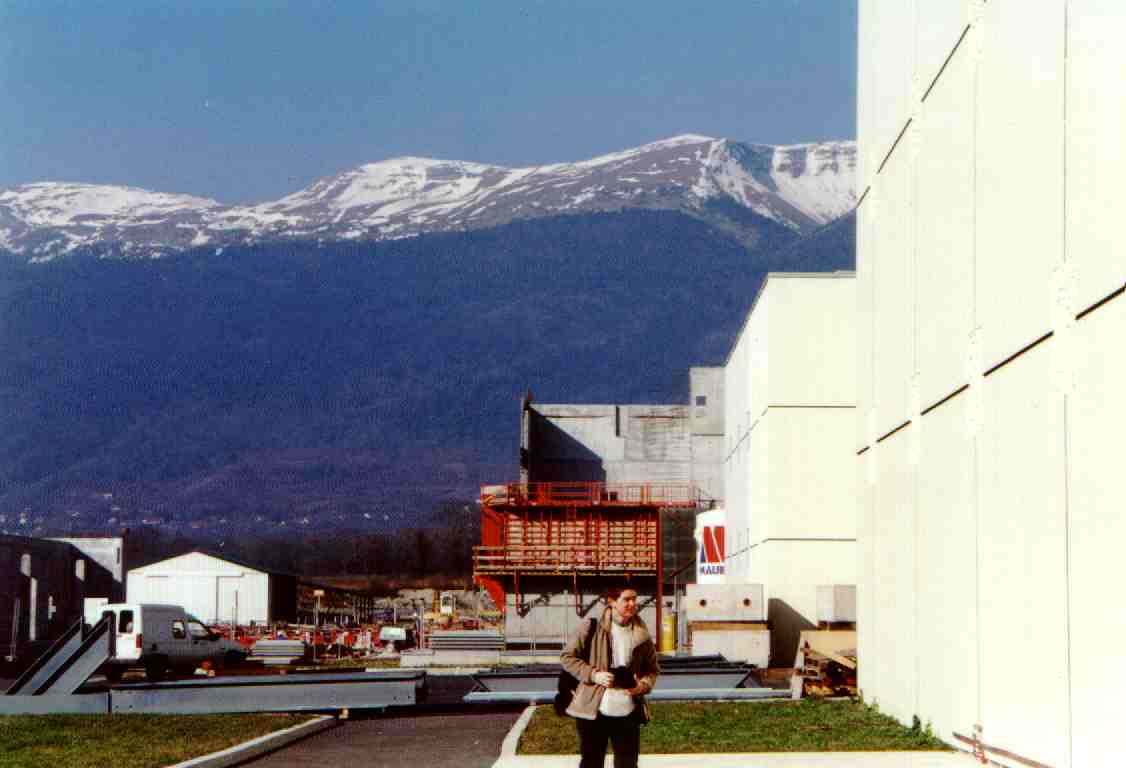 Jura
Mountains - from CMS Hall
Jura
Mountains - from CMS Hall
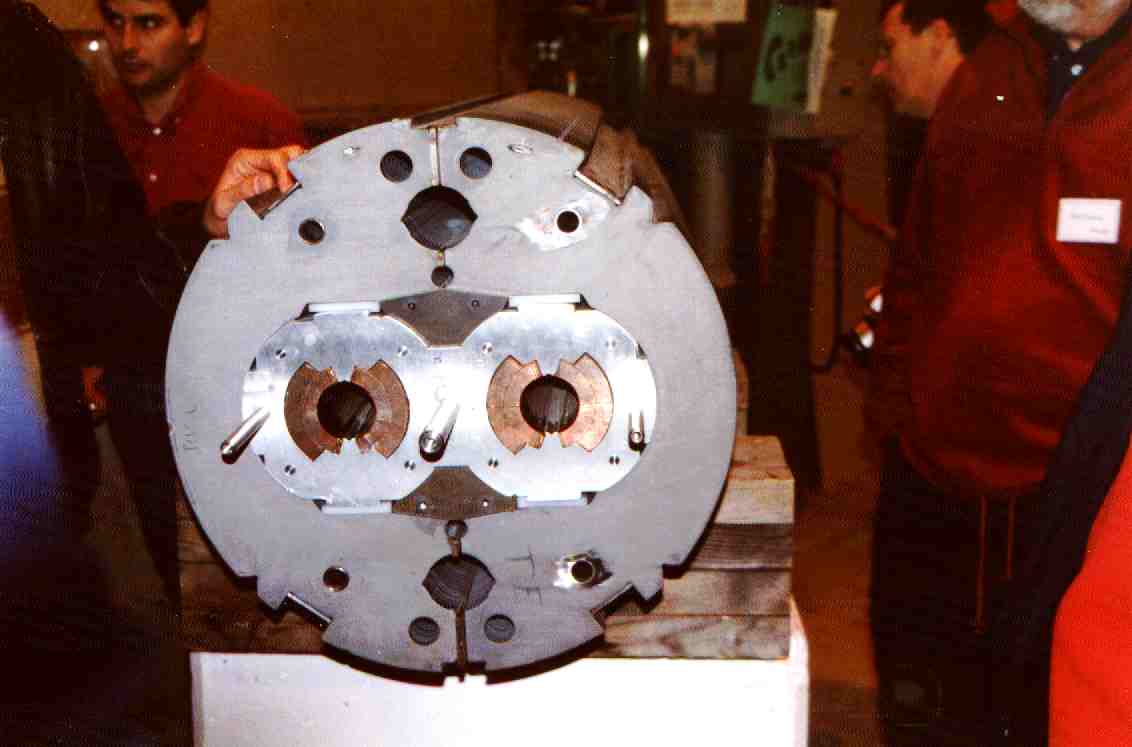 The Beam Pipe for the LHC
The Beam Pipe for the LHC
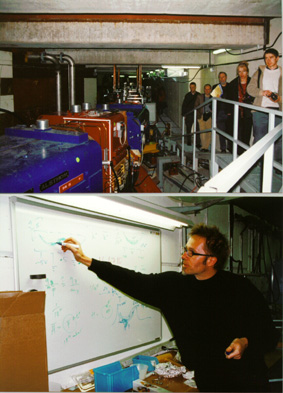 How to make Antihydrogen?
How to make Antihydrogen?
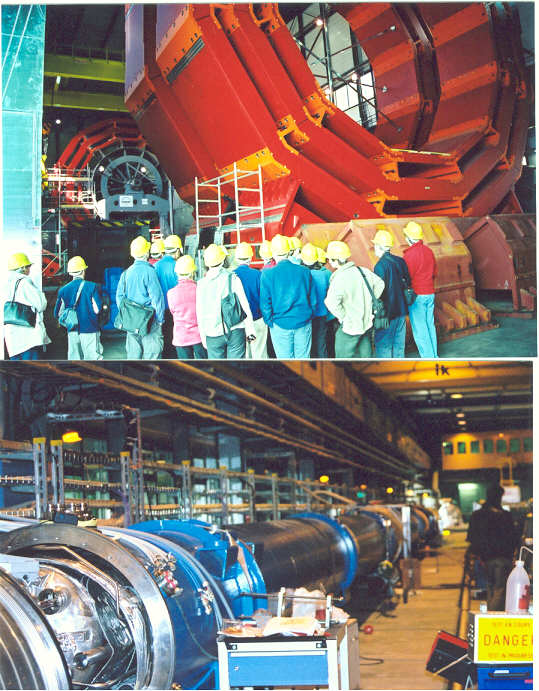 CMS
Detector and LHC test facility
CMS
Detector and LHC test facility